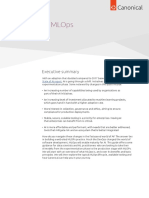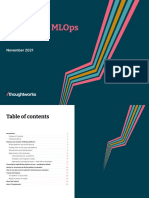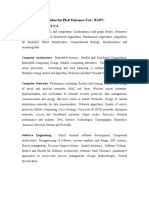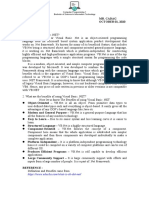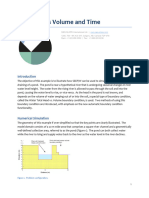▶️ DataSciLearn | Let's Learn Data Science
Roadmap to Learn MLOps from Basic to
Advanced
1. Foundations of MLOps
Goal: Understand the basics of MLOps, why it is needed, and the foundational concepts.
Topics to Learn:
● What is MLOps?
○ Importance of MLOps in the ML lifecycle.
○ MLOps vs DevOps.
○ Key components: ML model lifecycle, CI/CD, automation.
● Basic ML Workflow
○ Problem formulation, data preparation, model development, and deployment.
● Programming Fundamentals
○ Python (mandatory), familiarity with shell scripting.
○ Git and version control systems.
Tools to Explore:
● Python, Jupyter Notebook, Git/GitHub.
Resources:
● Courses: Coursera’s “Introduction to MLOps” or Fast.ai
● Book: "Practical MLOps" by Noah Gift.
2. Machine Learning Fundamentals
Goal: Strengthen ML knowledge to understand the deployment and monitoring aspects.
Topics to Learn:
● Supervised vs Unsupervised Learning.
DataSciLearn 📊 - YouTube
� ▶️ DataSciLearn | Let's Learn Data Science
● Model evaluation metrics (e.g., accuracy, precision, recall, AUC).
● Hyperparameter tuning.
● Overfitting vs Underfitting.
● Transfer Learning.
Tools to Explore:
● Scikit-learn, TensorFlow/PyTorch, XGBoost, LightGBM.
3. MLOps Core Concepts
Goal: Dive into key concepts specific to MLOps.
Topics to Learn:
1. Model Versioning
○ Tools like DVC, MLflow, or Weights & Biases (W&B).
○ Tracking experiments, datasets, and hyperparameters.
2. Model Deployment
○ What is deployment?
○ Types of deployments (Batch Inference, Real-Time Inference, Edge
Deployment).
3. Model Monitoring and Maintenance
○ Concept drift, model drift, and retraining pipelines.
○ Monitoring model performance over time.
Tools to Explore:
● MLflow, W&B, DVC.
Resources:
● Video tutorials on DVC and MLflow.
● Hands-on experimentation with Colab or local projects.
4. Cloud Platforms for MLOps
Goal: Learn to use cloud services for scalable MLOps practices.
DataSciLearn 📊 - YouTube
� ▶️ DataSciLearn | Let's Learn Data Science
Topics to Learn:
● Overview of Cloud Providers
○ AWS, GCP, Azure (pick one and specialize).
● Managed ML Services
○ AWS Sagemaker, Google Vertex AI, Azure ML Studio.
● Cloud Deployment Basics
○ Docker, Kubernetes, and serverless architectures.
● Infrastructure as Code (IaC)
○ Terraform, CloudFormation.
Tools to Explore:
● Docker, Kubernetes, AWS/GCP/Azure.
Resources:
● Free Cloud credits (Google Cloud’s free tier, AWS Educate).
● YouTube: "Introduction to Docker and Kubernetes for ML".
5. Data Engineering for MLOps
Goal: Learn to manage and preprocess data pipelines effectively.
Topics to Learn:
● ETL Pipelines (Extract, Transform, Load).
● Data Versioning and Lineage.
● Scalable data processing using Apache Spark or Databricks.
● Data Warehousing: Snowflake, BigQuery.
Tools to Explore:
● Apache Airflow, Prefect, Spark, Snowflake, BigQuery.
Resources:
● Datacamp courses on data engineering.
● Practical tutorials on Airflow and Spark.
DataSciLearn 📊 - YouTube
� ▶️ DataSciLearn | Let's Learn Data Science
6. Continuous Integration / Continuous Deployment
(CI/CD)
Goal: Learn CI/CD pipelines specific to ML workflows.
Topics to Learn:
● Building CI/CD pipelines for ML models.
● Automating testing of data, models, and code.
● GitHub Actions, Jenkins, CircleCI.
● Automated retraining pipelines.
Tools to Explore:
● GitHub Actions, Jenkins, Kubeflow Pipelines.
Resources:
● Blog: "MLOps with GitHub Actions".
● Hands-on projects using Kubeflow.
7. Advanced Topics in MLOps
Goal: Master the advanced tools and techniques in MLOps.
Topics to Learn:
1. Feature Stores
○ What is a feature store? Importance in MLOps.
○ Tools: Feast, Tecton.
2. Advanced Model Deployment
○ A/B testing, Canary Deployments, Multi-Model Serving.
3. Advanced Monitoring
○ Logging and alerting for ML pipelines.
○ Tools like Prometheus, Grafana.
4. Distributed Training and Serving
○ Horovod, Ray for distributed model training.
5. MLOps for Large Language Models (LLMs)
○ Fine-tuning, hosting, and monitoring LLMs.
DataSciLearn 📊 - YouTube
� ▶️ DataSciLearn | Let's Learn Data Science
Tools to Explore:
● Feast, Ray, Horovod, Prometheus, Grafana.
Resources:
● Advanced tutorials on LLM fine-tuning with Hugging Face.
● Blogs on feature stores and monitoring.
8. Security and Compliance in MLOps
Goal: Learn how to secure ML systems and ensure compliance.
Topics to Learn:
● Data privacy laws (GDPR, CCPA).
● Model explainability and interpretability.
● Secure model deployment practices.
● Adversarial attacks and defenses.
Tools to Explore:
● SHAP, LIME for interpretability.
● Presidio for data anonymization.
9. Projects and Portfolio Building
Goal: Build a portfolio showcasing end-to-end MLOps projects.
Suggested Projects:
1. End-to-End ML Pipeline
○ Data preprocessing, training, deployment, and monitoring.
2. Real-Time ML System
○ Deploy a real-time fraud detection or recommendation system.
3. Cloud-Based ML Workflow
○ Use AWS/GCP/Azure for a scalable ML solution.
DataSciLearn 📊 - YouTube
� ▶️ DataSciLearn | Let's Learn Data Science
Tools for Deployment:
● Streamlit, FastAPI, Flask for UI/API.
● Docker, Kubernetes for containerization.
10. Networking and Community Engagement
● Contribute to open-source MLOps projects.
● Join communities: MLOps Community Slack, GitHub repos, LinkedIn groups.
● Follow experts: Chip Huyen, Google MLOps blog.
DataSciLearn 📊 - YouTube




































